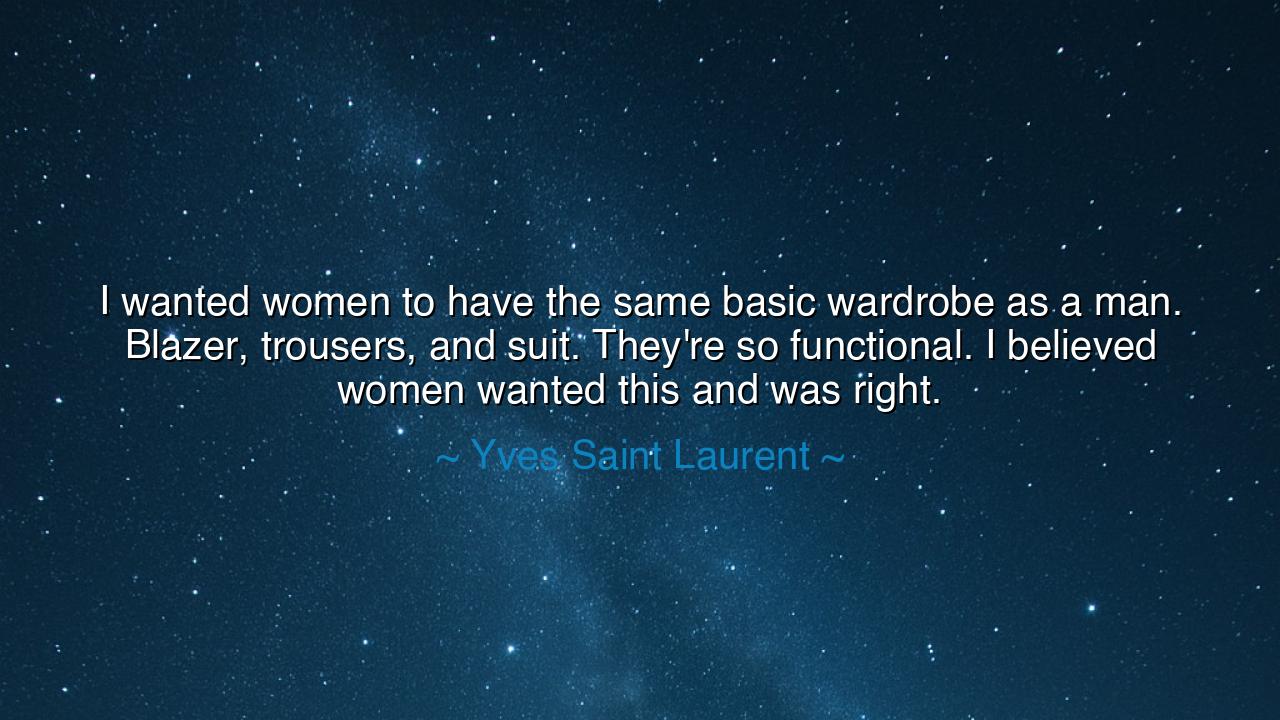
I wanted women to have the same basic wardrobe as a man. Blazer
I wanted women to have the same basic wardrobe as a man. Blazer, trousers, and suit. They're so functional. I believed women wanted this and was right.






When Yves Saint Laurent declared, “I wanted women to have the same basic wardrobe as a man. Blazer, trousers, and suit. They're so functional. I believed women wanted this and was right,” he was not merely speaking of fabric and seams, but of liberation. For the blazer, the trousers, and the suit were more than garments; they were armor, symbols of equality, and tools of empowerment. To place them upon women was to declare that they too had the right to walk into the world clothed in authority, not bound by lace or hemline.
The ancients themselves understood the power of attire. In Rome, the toga was a garment of citizenship and honor, denied to slaves and women alike. To wear it was to declare one’s place in the body politic. So too, for centuries, the suit had been the uniform of men, a silent declaration of their dominance in business, politics, and culture. When Saint Laurent dared to offer this attire to women, he was tearing down not only a wall of fashion, but a wall of society.
History offers vivid examples of how clothing became a battlefield of freedom. Amelia Bloomer in the 19th century advocated for women to wear trousers—“bloomers”—to free them from the prison of corsets and skirts. Though she was mocked, her vision foreshadowed the very triumph Saint Laurent achieved. In the 1960s and 70s, when women donned the tailored suit, they were no longer only secretaries in the office, but executives, lawyers, and leaders. The wardrobe itself became a banner of equality.
Saint Laurent’s genius was in recognizing that fashion could be functional and symbolic at once. By giving women the same functional tools as men, he helped to erase the distinction that confined them. He understood, with prophetic clarity, that women desired not only beauty, but power, and that the act of dressing could be both a declaration and a weapon.
Thus, let this teaching endure: the garments we wear are not mere coverings, but mirrors of society. To give women the blazer, trousers, and suit was to give them entry into halls once barred, to clothe them not as adornments but as equals. Saint Laurent’s creation was not only a triumph of fashion, but of freedom—a reminder that even in fabric, the struggle for dignity and equality is woven, thread by thread.






TNThanh Nga
Yves Saint Laurent was clearly a visionary in wanting to give women access to clothing that embodied both power and practicality. His belief that women wanted the same wardrobe choices as men was a bold and forward-thinking statement about equality. Given how much fashion has evolved since then, do you think we are still fighting for this level of gender-neutral functionality, or has fashion become more inclusive over time?
VNTran Van Nam
It’s fascinating that Yves Saint Laurent saw the practical nature of men’s clothing and believed women deserved the same functionality. What I find particularly interesting is how his designs challenged the status quo of femininity, which was often associated with dresses and skirts. In today’s fashion landscape, do you think we’ve truly moved beyond these gendered styles, or are women still expected to ‘dress for the role’ in many areas?
GDGold D.dragon
Saint Laurent’s design philosophy of offering women a functional, masculine-inspired wardrobe was revolutionary in its era. It made a powerful statement about breaking down traditional gender norms in fashion. But, looking at the evolution of fashion today, how do you think the lines between traditionally ‘male’ and ‘female’ clothing have blurred? Has this move toward more functional, unisex clothing had a lasting impact?
KHKhanh Huyen
Yves Saint Laurent's vision for women’s fashion was ahead of its time, creating a wardrobe that was both functional and empowering. His belief that women wanted the same basic wardrobe as men reflects a deeper understanding of gender equality, especially in the workplace. Do you think women today still face pressure to wear clothing that doesn’t prioritize functionality, or has fashion evolved to prioritize both style and comfort?